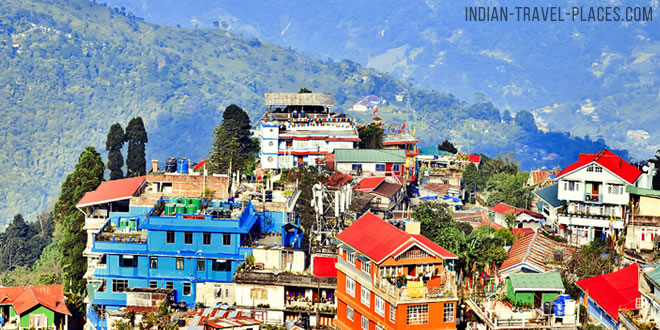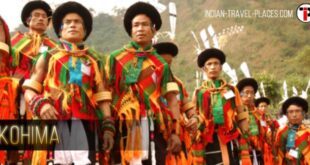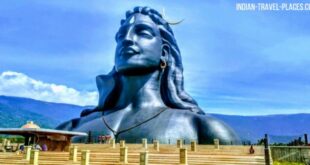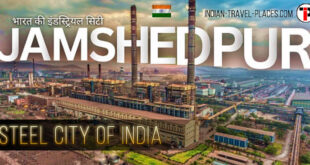| Name: | Darjeeling – Queen of the Hills |
| Location: | Darjeeling District, West Bengal, India |
| Climate: | Summers: 48° C (Max), 24° C (Min) | Winters: 36° C (Max), 9° C (Min) |
| Best Time To Visit: | May – June & September – November |
| Nearest Airport: | Bagdogra Airport (90 km) |
| Railway Station: | New Jalpaiguri (55 km) and Siliguri (77 km) |
| Must Visits: | Tiger Hill, Batasia Loop, Senchal Lake, Observatory Hill & Mahakal Temple, Dhirdham Temple, Padmaja Naidu Himalayan Zoological Park, Toy Train |
| Language Spoken: | Nepali, Bengali, Hindi and English |
| STD Code: | 0354 |
Warm heartedly referred to as “Queen of the Hills“, Darjeeling is an arresting town in the Indian state of West Bengal. This amazing town is nestled among the rolling mountains with the majestic Mt. Kanchenjunga. Darjeeling comes under the administrative district of Darjeeling and is located in the Mahabharat Range or Lesser Himalayas. This town is spread over an area of 1, 200 square miles at an average elevation of 2050 m above the sea level. Due to its location, this small town is blessed with picturesque landscapes, spectacular natural beauty and a temperate climate. This kind of climate includes soothing summer and cold winters; however the ideal time to explore Darjeeling is in the month of May to June & September to November. Darjeeling is world renowned for its tea industry and UNESCO World Heritage Site, Darjeeling Himalayan Railway.
With such beautiful and exotic natural beauty, Darjeeling proves itself to be a perfect gateways for people seeking to be in harmony with nature. The name ‘Darjeeling’ came from the Tibetan words, ‘dorje’ meaning thunderbolt (originally the scepter of Indra) and ‘ling’ a place or land, hence standing for ‘the land of the thunderbolt’. Until the 1835 when British arrived to this beautiful place, it was controlled by the Kingdoms of Bhutan, Sikkim and Nepal. They negotiated a lease of the area west of the Mahananda River from the Chogyal of Sikkim and till 1840; it became the summer capital for Bengal Residency. After independence in 1947, it became an eminent tourist place and escape for domestic as well as foreigner tourists. Darjeeling can be reached by the 88 km long Darjeeling Himalayan Railway from New Jalpaiguri Railway station. By road, it is just 77 km away from Siliguri.
Being located in Himalayan foothills, Darjeeling is home to exotic variety of flora and fauna. Some of the rare species of animals including one-horned rhinoceros, elephant, tiger, leopard and hog deer, while the main bird species include the Bengal florican and herons are found here. Tourism is a prominent factor for Darjeeling’s economy, after the tea industry. Tiger Hill, Batasia Loop and the War Memorial, Ava Art Gallery, Chowrasta and Mall, Rock Garden and Ganga Maya Park, Peace Pagoda, Botanical Garden,Srubbery Park, Darjeeling-Rangit Valley Passenger Cable Car, Senchal Lake, Observatory Hill & Mahakal Temple, Dhirdham Temple, Happy Valley Tea Garden, Padmaja Naidu Himalayan Zoological Park, Himalayan Mountaineering Institute, Raj Bhawan and Ghoom Monastery are some of the best tourist attractions in Darjeeling. To be precise, Darjeeling can certainly be defined with six T’s -Tea, Teak, Tourism, Toy Train, Tiger Hill and Trekkers’ paradise.
Best Time To Visit Darjeeling
Darjeeling, the queen of hills, is not just a huge rage among the tourists but also holds great interest for the filmmakers who love to infuse the lovely backdrop of Darjeeling in their movies. Darjeeling isn’t your typical tourism spot imbibed with same old visiting attractions or shopping streets. Every nook and corner of Darjeeling reflects uniqueness and echoes diversity in all aspects. It plays a perfect host to Buddhist monasteries, tea plantations, and the very rare Himalayan Red Panda. This tourism spot draws travelers from all around the globe throughout the year and is one of the favorite hill destinations in the country. If you are lucky enough to land up in Darjeeling, don’t miss to seize the golden opportunity of digging into its culinary delights, discovering the wonderful steep lanes, witnessing the colorful festivals and lastly, traveling around in a toy train. Find out more on the best time to visit Darjeeling by scrolling down the article.
When To Go To Darjeeling
Summer:
Unlike other cities that are worn out during scorching summers, Darjeeling has pleasant summers with the mercury levels never soaring beyond 25ºC. Thus, travelers don’t need to sweat out when walking on the roads or while exploring the lovely lanes of Darjeeling. The onset of summer starts from the month of April and lasts until June. So, the next time you are exhausted and finding it hard to beat the rising temperatures, you know which place to head out for.
Monsoon:
Monsoon is probably not the best time to hit Darjeeling as heavy rainfall and landslides threatens to mar your travel plans. Monsoon in Darjeeling begins from July and lasts uptil August. Though rains play a spoilsport during monsoon, Darjeeling looks totally green and spirited during this time. In case, the clatter of rain showers tempts you to gorge on something delicious, don’t hesitate to step into eatery outlets in Darjeeling to eat steamy momos served with hot chilli sauce.
Winter:
The temperature during winters can fluctuate anywhere between 5ºC to 7ºC. The nights are generally cold and local inhabitants can be seen draped in woolens to protect themselves from nippy cold. Hot beverages like tea, coffee, soups are more in demand during this period. Tourists planning to visit Darjeeling during this time must not forget to pack their bags with warm woolens. This time is specially preferred by honeymooners and the newly married couples who want to have the time of their lives with their loved ones.
Autumn:
The autumn months of September, October and November are the ideal time to visit Darjeeling, as the hill station is at its best during this time. Don’t forget to capture the beautiful locales and the crystal clear mountains on your camera lens if you are making a stopover at Darjeeling during autumn. It feels heavenly to relish the natural splendor of hilly place as you gulp down a cup of exotic and aromatic Darjeeling tea.
Spring:
Spring season, which lasts from February to March, is undoubtedly the most waited time in Darjeeling. This is the period when the new life awakens and fresh flowers bloom to its full glory. For trekkers and tourists, it’s the right time to explore this tourist destination. The temperature during the springtime hovers between 10ºC to 20ºC, making it convenient for the tourists to indulge in the city’s natural bliss.
Opting For Your Favorite Season:
The apt time to visit Darjeeling is between March to May and September to November. The perfect weather and clear blue sky makes it favorable to go for sightseeing or enjoy the panoramic views of Tiger Hills. All through the year, various kinds of festivals are celebrated with great gaiety and vigor. While in the month of May and June, Saga Dawa and Asar Ko Pandra is conducted, September and October seasons are marked by events such as Teej, Vishwakarma Puja and Dashain/ Dasain.
History:
The history of Darjeeling is closely intertwined with that of Bengal, Nepal, Bhutan, Sikkim and Great Britain. Once a part of Sikkim and home to several aboriginal tribal communities, much of the history of Darjeeling is soused in combats with neighboring ethnic groups. Darjeeling has always been a soft target for the powerful forces of Bhutan and Nepal. In 1780, Nepal army seized a major portion of Sikkim’s boundaries and established their dominance over the land. The victory of the British in the Anglo-Nepal played a significant role in shaping the history of Darjeeling and driving out the Gorkhas from the land. Under the British rule, a major part of Sikkim’s lost precincts were recaptured and reinstated. Over the years, Darjeeling developed with the establishment of medical centers and tea plantations. During this time, the region served as the summer capital to several British officials, high ranking administers, princely dignitaries, rich merchants, and landlords. Read the article to know more about the history of Darjeeling.
Darjeeling History
Early Settlers:
Prior to the rule of the royal leaders of Sikkim, the place was inhabited by Lepchas, Limbus, and Bhutias who are considered to be the original settlers in the region. It was only in 1642 that Darjeeling came under the governance of Phuntsog Namgyal, who is said to be the descendent of Guru Tashi. Guru Tashi is believed to be a member of the royal Minyak house. After the death of Phuntsog Namgyal, the province came under the rule of his son Tensung Namgyal who failed to protect the region from the invasion of Bhutan army. Towards 1780, the Gorkha regiment annexed the hilly terrain. The Gorkha army seized a huge chunk of Sikkim’s landmass. Despite constant efforts by the Chogyal leaders to recapture the place, the leaders of Sikkim remained unsuccessful until they availed the help of British.
East India Company Rule:
With the combined efforts of the colonial rulers and Sikkim’s chief, Nepal army was defeated in the Anglo-Gorkha war and the Nepal regiment was forced to sign the treaty of Sugauli in the year 1815. According to the treaty, Nepal had to relinquish almost one-third of the land, which they had occupied. After the treaty, the British officially commanded a politically higher position in the region. Two years later, in the year 1817, the East Indian Company signed another treaty with the Sikkim rulers known as the Treaty of Titalia. As per this treaty, the Sikkim rulers were given the right to rule the lands, which the British had acquired in return of trading rights. In 1835, the British entered into a lease contract with them in order to commence trading activity. Over the years, Darjeeling progressed at a fast pace with improved medical services and profitable tea estates that were most sought after in Europe. During this period, the Chogyal leaders were unhappy with the growing migrant population that entered the place due to the potential growth in Darjeeling’s economy. This caused uproar among the reigning rulers of the hill-station. With deteriorating relationships between the two parties, the district of Darjeeling soon fell into the hands of the English rule. In the following years, Darjeeling saw a major development in the educational sector, infrastructure, and tourism.
After-Independence:
After India gained its independence, the district of Darjeeling was merged with the state of West Bengal. In 1980, differences between numerous ethnic communities gave rise to the internal disturbance in the region. This in turn led to several protest and claim for a separate Gorkhaland. The formation of Darjeeling Gorkha Hill Council reduced political pressures in the province. Today, however, the DGHC enjoys semi-autonomous powers to administer the district.
How To Reach:
A popular tourist destination, Darjeeling attracts tons of glob trekkers from all over the world, eager to explore the Himalayan charm. Enveloped by snow-white mountains, thick towering deciduous alpine forests and extensive tea plantations, Darjeeling is truly West Bengal’s premier tourist destination. As you gaze through Darjeeling’s scenery and marvel at its natural bounties, don’t skip the chance to sample some the finest quality tealeaves handpicked from its aromatic tea gardens. While strolling around the hill-station, stop to stare at the colonial-styled ziggurats that bear the influence of British India and the colorful prayer flags that remind you of Buddhist dominance over the land. As you explore the city’s extravagance, make a quick jaunt to the shopping streets to pick up colorful souvenirs for yourself and stopover at the local eateries and sample the steaming brew and yummy Tibetan fare. Since the place is a significant tourist destination in India, Darjeeling is well connected to other major cities. Read the article to know more on how to reach Darjeeling.
Traveling To Darjeeling
By Air:
Darjeeling does not have an airport of its own. The closest airfield is located in Bagdogra near Siliguri, which is 90 km away from the hill-station. The airport is connected to the cities of Delhi, Kolkata, Guwahati and Patna by domestic airlines like Jet Airways, Indian Airlines, Spice Jet, Kingfisher and Air Deccan. International travelers can avail connecting flights from Kolkata or Delhi. Once you arrive at the airport, you can board a local bus, hire a taxi or rent a jeep that will take you to Darjeeling in matter of two or three hours. Although commuting through air may seem to be an expensive affair as compared to traveling by road, nevertheless boarding a flight would make your journey hassle-free.
By Rail:
The nearest railhead to Darjeeling is New Jalpaiguri Railway Station that is situated just 88 km away from the city. Apart from that, Darjeeling is also connected to Siliguri railway station. If you plan to commute through rail, then you can take any train that makes a halt at New Jalpaiguri or Siliguri railway station. On reaching either of the stations, you can hire a taxi to reach Darjeeling. However, if you wish to be a little more adventurous and explore the scenic landscape of Darjeeling as you travel along, then boarding the toy train that plies regularly from Darjeeling to Siliguri and New Jalpaiguri would serve your needs.
By Road:
Although the place does not have great transport facility, the roads connecting Darjeeling are well maintained and connect the hill-station to different towns in West Bengal. Both state and national highways interlink the city to tourist hotspots and important cities nearby. In order to promote tourism, there are several buses and taxis that shuttle from Darjeeling to Siliguri, Kurseong, Kathmandu, Gangtok, Bagdogra on a regular basis. Does not matter if you prefer rail or airway to road, nothing can match the absolute thrill of driving down the scenic routes in Darjeeling.
Local Transport:
Whether you wish to do some rubbernecking or just explore the countryside, hiring a taxi, jeep, auto or a tourist vehicle would take you anywhere within the city. For more adventure hearts, you can hire land rovers or jeeps and drive down the tea gardens or explore the hillscape. What’s more, for more budget-conscious tourists, there are shared matadors and minibuses that will take you to your chosen destination in cheap prices.
Shopping In Darjeeling
Darjeeling is one of the topnotch tourism destinations in India. The snow-capped mountains along with orchid gardens and scented tea valleys are good enough to transport you to a fairyland. This charming Victorian town never seems to sleep and for shoppers, Darjeeling is an absolute haven. The shops flanked across the city lanes are loaded with some incredible and breathtaking souvenir shops. After an exhaustive shopping, look around for local eateries and eat to your heart’s content. Some of the must-try dishes are thupka, momos, wai wai and churpees. After blissful gorging, wash the fare down with a cup of spicy Darjeeling tea and get ready to go for another round of shopping spree. Visit Darjeeling in the month of March-May or September-November to get the most of this town. So, if you are planning a visit to this wonderful place, it’s best to keep yourself informed about the shopping places in Darjeeling. Compiled below is the list of top shopping spots in Darjeeling. Check them out.
Shopping Places In Darjeeling
Nathmulls Tea Cosy:
Tea connoisseurs should take their time off their busy travel schedule and make it a point to visit this wonderful place. A wide range of tantalizing tea of various flavors can be purchased from this tea boutique. Buy gift packs of estate and fruit teas that are most popular selling items. Also, check out the tea accessories such as teapots, teaspoons and cups, different variety of strainers and infusers that are on display and sale here. Nathmulls Tea Cosy is located on Ladenla Road.
Chowrasta Road:
Chowrasta Road is an interesting curio corner in Darjeeling. Tourists and local inhabitants can be seen buying items like wood carving, brass statues, thangkas, jewelry, woven fabrics and carpets. It is advised to bargain generously to not let the best deals slip out of your hand. The lane is narrow and gets crowded most of the times, especially during the late evenings.
Das Studios:
How about gifting exclusive photographic prints of Khangchendzonga and other picturesque spots of Darjeeling to your dear ones? Sounds exciting, isn’t it! Das Studios situated near Nehru Road City Center is a place to head out for if you want to buy never-seen-before pictures of this exotic hill station. Apart from photography lovers, even tourists gather here to take a look at the portraits and buy them.
Art Emporium:
Halt over at Art Emporium to browse and shop for Tibetan handicrafts, sweaters, knitted apparels, cardigans, pullovers and other trendy garments. The collection of silk and handloom products found here is eye-catching. Kalimpong Art Gallery and West Bengal’s Manusha Emporium situated at Nehru Road are some of the other alternative places to shop for Himalayan handicrafts and related stuffs.
Hill Cart Road:
If you don’t want to burn a big hole in your pocket while buying woolen sweaters and apparels, then hitting the Hill Cart Road is the safest option. The bamboo items including bamboo umbrella found here is visually delightful and totally worth buying. Hill Cart Road is not just a good place to hang out with friends but also a great spot to while away your time and indulge in window-shopping.
Tibetan Refugee Self-Help Center:
Located on Lebong Card Road is this humble Tibetan Refugee Self-help Center that sells fine-striking carpets, wood carved products, leather work and Tibetan curios. The profits garnered from the sale goes directly to the needy Tibetans who work there.
 ITP Indian Travel Places: Food, Travel, Tourism Business Events and Trade Shows
ITP Indian Travel Places: Food, Travel, Tourism Business Events and Trade Shows







